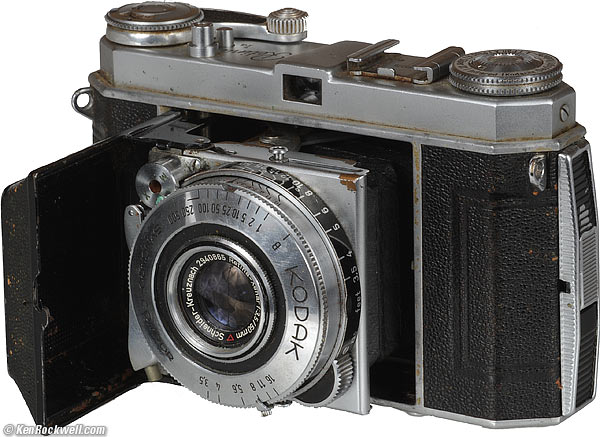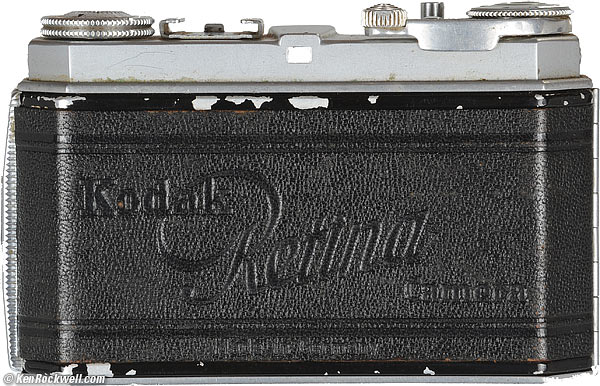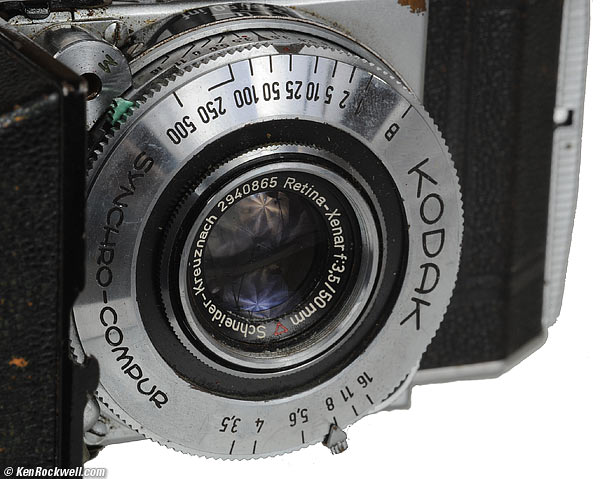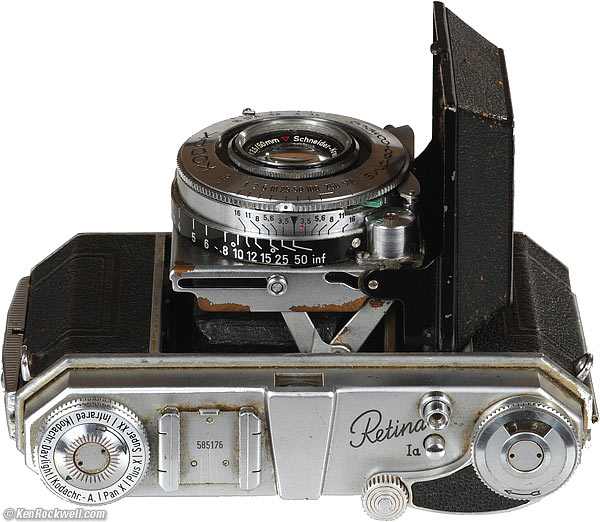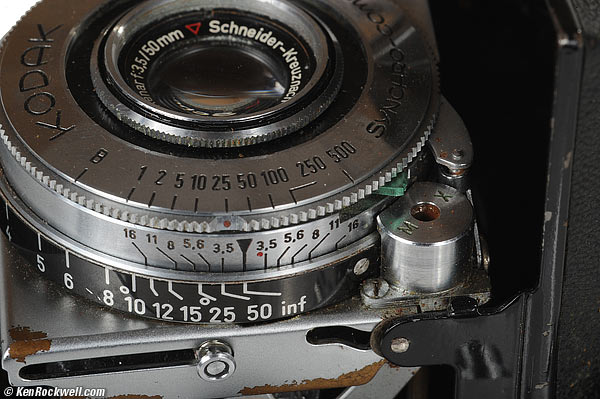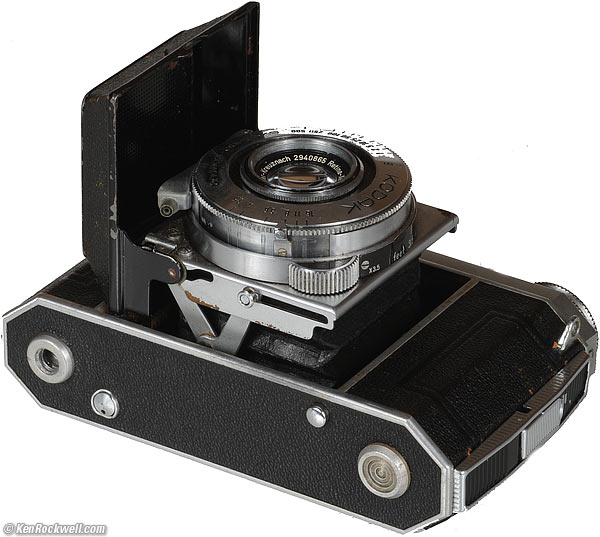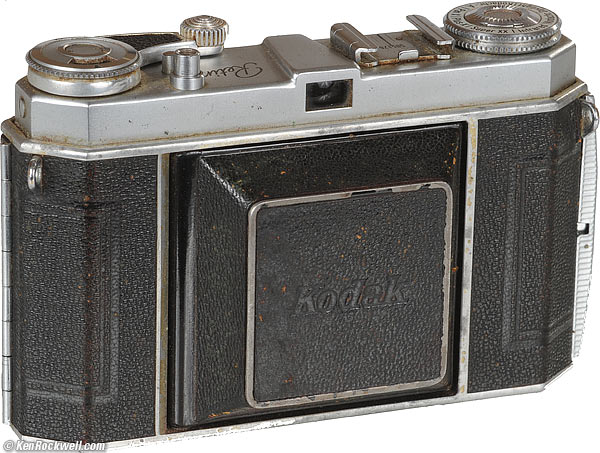Home New Search Gallery How-To Books Links Workshops About Contact
Kodak Retina 1a Kodak Retina 1a. enlarge. I get my goodies at Ritz, Amazon and Adorama. It helps me keep adding to this site when you get yours from these links, too. July 2008 Nikon Reviews Canon Reviews Intro Specs Performance Usage Recommendations This is a folding 35mm camera. There is a small bellows between the lens board and the rest of the camera for when the lens extends. The Kodak Retina cameras were extremely high-quality German-made cameras which were popular throughout the 1950s. Online apocrypha suggest this was model 015, was made about 1951-1954 and wasn't sold in the USA. Real data tells me the Schneider lens serial number suggests the lens was made in 1950, and I have a copy of the December 1949 issue of Modern Photography where the Retina 1a is offered for sale, both new and used, which goes to show you never to believe anything experts post on the Internet. The 1a is among the first of the series, which was popular throughout the 1950s. Ask a collector for the details, and as I recall, the cameras got fancier, eventually winding up a the model IIIC, with an f/2 lens, light meter and coupled rangefinder. Kodak made about 140,000 of this model 1a in Stuttgart, Germany. Embossed Leather Back. enlarge. This particular Retina 1a camera is a great example of how extremely high quality has little to do with making great pictures. This camera, a jewel of precision, is almost useless for practical photography. This camera is so simple that it has no light meter and no way to focus! You need an external light meter or need to guess at manual exposure. It has no rangefinder. Back in these days, internal coupled rangefinders were exotic. Common people bought external rangefinders or simply guessed at the subject distance. External rangefinders were often slipped into the accessory shoe. You read or guess the distance, and then set this on the lens' focus scale! As a top-quality product, it was expensive. It sold for aroud $500 - $1,000 new, as corrected for inflation in 2008.
Specifications with commentary back to top Intro Specs Performance Usage Recommendations
Lens and shutter, Retina 1a. Lens: Schneider Xenar 50mm f/3.5, I presume a Tessar variant. Diaphragm: 10 blades stopping down to f/16. Full-stop clicks, can stop down past f/16 to about an unmarked f/32. Shutter: Synchro-Compur 1-1/500 sec and Bulb. Flash Sync: X-sync at all speeds up to 1/500 (better than the $5,000 Nikon D3 and $8,000 Canon 1Ds Mk III). Selectable M sync for flashbulbs. Focus: By scale in feet, only. Infra-Red Focus Index: Yes. Film Wind: Top Lever. Film Rewind: Manual, by knob (not crank). Frame Counter: Manual reset, counts down. Cable Release Socket: Yes, in shutter button. Size: 3-1/8" high, 4-3/4" wide and 3-3/8" deep, open. When closed, its only 1-5/8" deep. In the 1950s, US consumers had no idea of the metric system, but if they did, the measurements would have been 79 x 121 x 86mm, and 41mm thick when closed. Weight: 17.642 oz. (500.15g), without case and without film. Quality: Made in Germany. Top, Retina 1a. enlarge.
Performance back to top Intro Specs Performance Usage Recommendations Flowers, as shot on outdated Kodak 400 print film. enlarge. The Retina is a marvel of precision. It has a great lens and a super-smooth, super quiet leaf shutter. Many operational aspects are corny, however film advance and shutter release feel and sound great. The lens is sharp, even in the corners and even wide open. There is a little falloff (darkened corners) wide open, and it's perfect by f/5.6. The gotcha is that its very difficult to make perfect images, because focus is by distance scale only. You need a separate rangefinder, and a separate exposure meter to use it. When I shot it, I shot print film and mostly guessed at exposure from experience. I stopped down far and guessed at focus distances. This works great for scenic shots, but is a bear for shooting close-ups.
Usage back to top Intro Specs Performance Usage Recommendations
Bottom, with never-ready case. To open, press the small chrome button on the bottom. Swing out the front until it snaps. To load this Retina, remove the case and open the back by pulling down the lever on the left, as seen from the rear. Thread the film. Spin the frame counter to the diamond to the right of 36 for a 36-exposure roll, or to the diamond to the right of 20 for a 20-exposure roll. Whoops, film has come in 24, not 20, exposure rolls since the 1980s. With a 24-exposure roll, set the counter to 27. Set the film-type reminder on the top left knob, if you can find your film there. Tri-X won't be invented until 8 years after this camera! Likewise, there was no color print film yet: only B&W and Kodachrome. When loaded, close the back, and wind and shoot until you get to one before the number of exposures on your roll. Wind the lever to cock the shutter to be ready to shoot. It's best not to cock the shutter until you intend to shoot; put the camera away uncocked. Guess your exposure and set it. In the old days, film came with instructions which included exposure settings for all light conditions. Your film just might have this; look inside the box.
Shutter, focus and depth-of-field scales. Guess at the distance, and set it on the focus ring. Shoot! The shutter is almost silent; you won't hear it in noisy conditions. Always press the shutter deliberately. If you press it only partway and change your mind, the double-exposure prevention can think you took a picture, requiring you to advance the film with that frame unexposed. To close the Retina 1a, first set the focus to infinity. Then press the small knob just below the 25-foot mark in the photo above, at the same time as the matching knob on the bottom of the lens mount seen below. Carefully swing the front closed until it snaps. Bottom, Retina 1a. enlarge. From left to right on bottom panel: tripod socket, rewind button, lens door release, chrome trim.
Kodak Retina 1a, closed and ready to pocket. When the frame counter reaches 1 and you've made that shot, the advance lever locks. This way you know the film's done. To rewind, press the rewind button (the inset button on the bottom with the small black dot), lift the top left knob and start turning it clockwise. There's an arrow on it to remind you in which direction you should turn it. There is a second smaller button next to the shutter release on the top. It is a weird feature that lets you advance the film without taking a picture. It's the reverse of a multiple-exposure button; it's a zero-exposure button. Back in the 1950s, you changed ISO or changed between color and B&W by changing rolls of film halfway through.
Recommendations back to top Intro Specs Performance Usage Recommendations If you find on for $5 at a garage sale, pick it up. I would never get one of these as a primary camera. Make sure the shutter really runs for 1 second when set to one second. Many cameras this old have shutters which stick open at slow speeds. If you really want to shoot with one of these, try a different model with a built-in rangefinder, and even better, one with a working meter. If you have a newer one, like one of the Automatics or IIIc, feel free to let me review it if you like. I have no access to these otherwise. This one was given to me. Thank you!
More Information: See Mike Butkus' site for Kodak Retina Users Manuals, and send him a few bucks for helping all of us out.
PLUG If you find this as helpful as a book you might have had to buy or a workshop you may have had to take, feel free to help me continue helping everyone. If you've gotten your gear through one of my links or helped otherwise, you're family, thank you! If you haven't helped yet, please do, and consider helping me with a gift of $5.00. I support my family through this website. Thanks for reading!
Ken
|
Home New Search Gallery How-To Books Links Workshops About Contact

